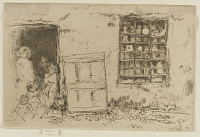The Village Sweet Shop | ||
| Number: | 266 | |
| Date: | 1886 | |
| Medium: | etching | |
| Size: | 82 x 124 mm | |
| Signed: | butterfly at right | |
| Inscribed: | no | |
| Set/Publication: | no | |
| No. of States: | 1 | |
| Known impressions: | 14 | |
| Catalogues: | K.251; M.247; W.205 | |
| Impressions taken from this plate (14) | ||
KEYWORD
children, confectioner, shop, shop-front.
TITLE
The subject is a sweet shop, and this forms the basis for minor variations in the title, as follows:
'The Village Sweet-Shop' (1886, Frederick Wedmore (1844-1921)). 3
'The Village Sweet shop' (1887, Whistler). 4
'The Sweet Shop' (1887/1888, Whistler). 5
'The Sweet Shop' (1888, Brussels). 6
'Sweet Shop' (1889, Whistler). 7
'The Little Sweet Shop' (1893, Chicago). 8
'Sweet shop. Sandwich' (1903/1935?, possibly Rosalind Birnie Philip (1873-1958)). 9
'Au village. Le marchand de bonbons - (the Village Sweet-Shop)' (1905, Paris). 10
Miss Birnie Philip recorded the site as Sandwich, as well as the subject as 'Sweet Shop'; this is probably correct, but is not certain, since Whistler did not use the town's name in the title.
Given this slight uncertainty, it is preferable to revert to Whistler's original title, 'The Village Sweet Shop', which was that favoured by other cataloguers, from Wedmore on.
'The Village Sweet-Shop' (1886, Frederick Wedmore (1844-1921)). 3
'The Village Sweet shop' (1887, Whistler). 4
'The Sweet Shop' (1887/1888, Whistler). 5
'The Sweet Shop' (1888, Brussels). 6
'Sweet Shop' (1889, Whistler). 7
'The Little Sweet Shop' (1893, Chicago). 8
'Sweet shop. Sandwich' (1903/1935?, possibly Rosalind Birnie Philip (1873-1958)). 9
'Au village. Le marchand de bonbons - (the Village Sweet-Shop)' (1905, Paris). 10
Miss Birnie Philip recorded the site as Sandwich, as well as the subject as 'Sweet Shop'; this is probably correct, but is not certain, since Whistler did not use the town's name in the title.
Given this slight uncertainty, it is preferable to revert to Whistler's original title, 'The Village Sweet Shop', which was that favoured by other cataloguers, from Wedmore on.
3: Wedmore 1886 A (cat. no. 205).
4: Letter to Dowdeswell, 27 July 1887, GUW #08677.
5: List, [1887/1888], GUW #13233.
6: Brussels 1888 (cat. no. 6).
7: List, 18 July 1889, GUW #13235.
8: Chicago 1893 (cat. no. 2254).
9: Envelope containing the copper plate, University of Glasgow.
10: Paris Mem. 1905 (cat. no. 384).
DESCRIPTION
At left is a low, open doorway, with a child and a baby sitting on the doorstep. In the doorway at left stands a taller girl with a scarf over her head, and to right is a small boy with his right hand raised to his face. He appears to be wearing a cap and possibly a mask. In the shadows behind them is another figure. Propped against the wall, to right of the doorway, is a large wooden shutter. At the right is a shop-window covered by an irregular grid, made either of wood or iron. Three slightly lop-sided shelves inside the window are filled with boxes and tall glass jars of sweets. The wall is roughly plastered and the ground, cobbled.
SITE
This may have been etched in the small town of Sandwich, Kent, in the south of England. Whistler made several etchings there including Salvation Army, Sandwich [319], Double Doorway, Sandwich [322] and Doorway, Sandwich [323]. 11
11: Hopkinson 2001.
DISCUSSION
A few years earlier Whistler had painted a similar subject, An Orange Note: Sweet Shop [y264]. Lochnan commented, 'Whistler's developing interest in transparency and translucency was explored in the etching of sweets barely visible through the glass of the shop windows.' 12
12: Lochnan 1984, p. 228.
The asymmetry of the composition in the etching creates complex spatial divisions. The children are indicated imprecisely so that it is hard to identify the sex, age and dress of some of them. The goods in the window create texture and an illusion of detail but the shapes are hard to interpret. There is a similar use of detail and pattern, within a more regular geometrical framework, in a later etching, The Embroidered Curtain [451].
